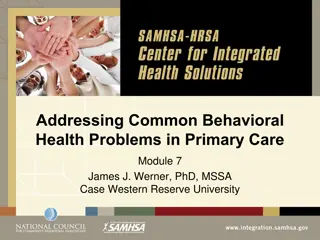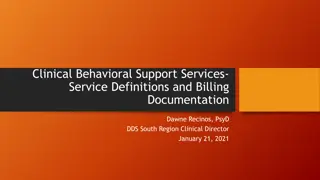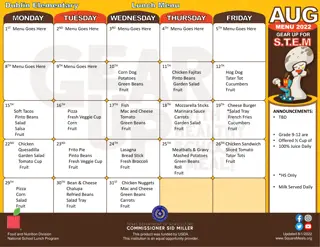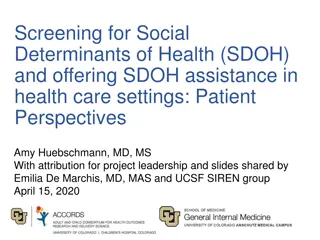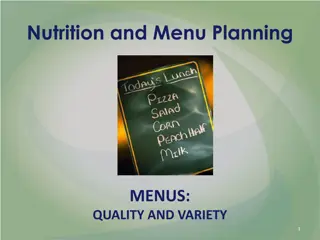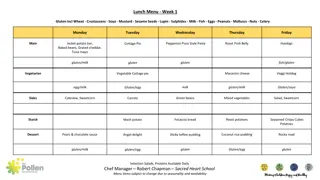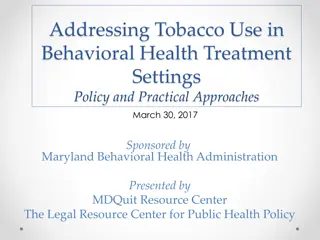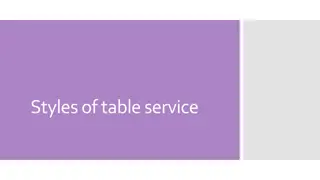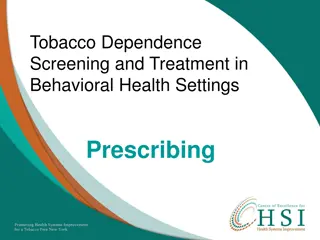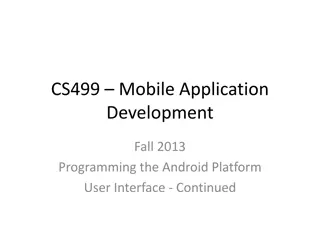Behavioral Menus in Healthcare Settings
Discover the versatile use of behavioral menus in healthcare, from agenda setting to brainstorming. Adapt these templates for agenda prioritization and focus. Learn about the importance of discussing health concerns with your care team. Explore topics like monitoring health, medication management, lifestyle habits, and more. Utilize resources on motivational interviewing and healthy behavior change for effective communication.
Download Presentation

Please find below an Image/Link to download the presentation.
The content on the website is provided AS IS for your information and personal use only. It may not be sold, licensed, or shared on other websites without obtaining consent from the author.If you encounter any issues during the download, it is possible that the publisher has removed the file from their server.
You are allowed to download the files provided on this website for personal or commercial use, subject to the condition that they are used lawfully. All files are the property of their respective owners.
The content on the website is provided AS IS for your information and personal use only. It may not be sold, licensed, or shared on other websites without obtaining consent from the author.
E N D
Presentation Transcript
Behavioural Menus There are many ways that you can use a behavioural menu. Some examples include: Before a visit for people to provide their input on the agenda During the visit to help focus or prioritize topics As a way to brainstorm ideas A behavioral menu can be done verbally or on paper. The menus in this package are meant to assist in agenda setting, focusing, prioritizing and brainstorming. They can be adapted to meet the needs of the people that you serve. All of the images in these templates are PowerPoint icons or CCMI original designs. You can access powerpoint icons by going to the insert tab. If you use images from outside of PowerPoint, please ensure that they are public domain sources. Please note the creative commons licenses at the bottom of the page, which are meant as guidelines for adaptation, copying and distribution. For more information about creative commons, please visit: https://creativecommons.org/licenses/ You might also find the information about Ask-Tell-Ask useful when offering ideas or giving information or advice: https://centrecmi.ca/wp-content/uploads/2019/03/12-Ask_Tell_Ask_2018-12- 21.pdf Sources on Behavioural Menus: Sources on Behavioural Menus: Rollnick R, Mason P, Butler C. Healthy Behavior Change: A Guide for Practitioners. New York: Churchill Livingstone; 1999. Rollnick S, Miller WR, Butler C. Motivational Interviewing in Health Care: Helping Patients Change Behavior. New York: Guilford Press; 2008. Stott N, Rollnick S, Rees M, Pill R. Innovation in clinical method: diabetes care and negotiating skills. Family Practice. 1995;12(4):413-418. www.centreCMI.ca
There are many things people do for their health. Here are some things you might want to talk to your health care team about. Choose to talk about changing any of these and add other concerns in the blank circles. Monitoring your health Taking medications Smoking Meaningful activities Mood Eating habits Activity Rollnick R, Mason P, Butler C. Healthy Behavior Change: A Guide for Practitioners. New York: Churchill Livingstone; 1999. Rollnick S, Miller WR, Butler C. Motivational Interviewing in Health Care: Helping Patients Change Behavior. New York: Guilford Press; 2008. Stott N, Rollnick S, Rees M, Pill R. Innovation in clinical method: diabetes care and negotiating skills. Family Practice. 1995;12(4):413-418. www.centreCMI.ca
If you have heart disease, here are some things you can talk about with your health care team. Choose to talk about changing any of these and add other concerns in the blank circles. Blood pressure monitoring Taking medications Physical activity Avoiding strokes or heart attacks Weight Mood Eating habits Smoking Rollnick R, Mason P, Butler C. Healthy Behavior Change: A Guide for Practitioners. New York: Churchill Livingstone; 1999. Rollnick S, Miller WR, Butler C. Motivational Interviewing in Health Care: Helping Patients Change Behavior. New York: Guilford Press; 2008. Stott N, Rollnick S, Rees M, Pill R. Innovation in clinical method: diabetes care and negotiating skills. Family Practice. 1995;12(4):413-418. www.centreCMI.ca
As seniors, there are many things people do for their health. Here are some things you might want to talk to your health care team about. Choose to talk about changing any of these and add other concerns in the blank circles. Falls Taking medications Living situation Meaningful Activities Planning ahead Mood Bathroom concerns Memory Rollnick R, Mason P, Butler C. Healthy Behavior Change: A Guide for Practitioners. New York: Churchill Livingstone; 1999. Rollnick S, Miller WR, Butler C. Motivational Interviewing in Health Care: Helping Patients Change Behavior. New York: Guilford Press; 2008. Stott N, Rollnick S, Rees M, Pill R. Innovation in clinical method: diabetes care and negotiating skills. Family Practice. 1995;12(4):413-418. www.centreCMI.ca
If you have diabetes, here are some things you can talk about with your health care team. Choose to talk about changing any of these and add other concerns in the blank circles. Blood glucose monitoring Taking medications Physical activity Avoiding strokes or heart attacks Weight Mood Eating habits Daily foot care Smoking Rollnick R, Mason P, Butler C. Healthy Behavior Change: A Guide for Practitioners. New York: Churchill Livingstone; 1999. Rollnick S, Miller WR, Butler C. Motivational Interviewing in Health Care: Helping Patients Change Behavior. New York: Guilford Press; 2008. Stott N, Rollnick S, Rees M, Pill R. Innovation in clinical method: diabetes care and negotiating skills. Family Practice. 1995;12(4):413-418. www.centreCMI.ca
If you have depression, here are some things you can talk about with your health care team. Choose to talk about changing any of these and add other concerns in the blank circles. Monitoring Taking medication Something you used to enjoy Physical activity Completing a small task Rollnick R, Mason P, Butler C. Healthy Behavior Change: A Guide for Practitioners. New York: Churchill Livingstone; 1999. Rollnick S, Miller WR, Butler C. Motivational Interviewing in Health Care: Helping Patients Change Behavior. New York: Guilford Press; 2008. Stott N, Rollnick S, Rees M, Pill R. Innovation in clinical method: diabetes care and negotiating skills. Family Practice. 1995;12(4):413-418. www.centreCMI.ca
For healthy children, here are some possible ideas. Choose to talk about changing any of these and add other concerns in the blank circles. Physical activity Food choices Screen time Sugary drinks Rollnick R, Mason P, Butler C. Healthy Behavior Change: A Guide for Practitioners. New York: Churchill Livingstone; 1999. Rollnick S, Miller WR, Butler C. Motivational Interviewing in Health Care: Helping Patients Change Behavior. New York: Guilford Press; 2008. Stott N, Rollnick S, Rees M, Pill R. Innovation in clinical method: diabetes care and negotiating skills. Family Practice. 1995;12(4):413-418. www.centreCMI.ca
If you are interested in increasing your physical activity, here are some possible ideas. Choose to talk about changing any of these and add other concerns in the blank circles. Walking Organized sports Daily monitoring Standing desk Food choices Take the stairs Rollnick R, Mason P, Butler C. Healthy Behavior Change: A Guide for Practitioners. New York: Churchill Livingstone; 1999. Rollnick S, Miller WR, Butler C. Motivational Interviewing in Health Care: Helping Patients Change Behavior. New York: Guilford Press; 2008. Stott N, Rollnick S, Rees M, Pill R. Innovation in clinical method: diabetes care and negotiating skills. Family Practice. 1995;12(4):413-418. www.centreCMI.ca
If you have decided to reduce or stop your use of alcohol, here are some things that others have found helpful in cutting back. Choose to talk about changing any of these and add other concerns in the blank circles. Monitor patterns and identify triggers Meaningful activities or connections Limit drinks by time (#/hr) Ask for support Physical activity Switch to a non-alcoholic drink Rollnick R, Mason P, Butler C. Healthy Behavior Change: A Guide for Practitioners. New York: Churchill Livingstone; 1999. Rollnick S, Miller WR, Butler C. Motivational Interviewing in Health Care: Helping Patients Change Behavior. New York: Guilford Press; 2008. Stott N, Rollnick S, Rees M, Pill R. Innovation in clinical method: diabetes care and negotiating skills. Family Practice. 1995;12(4):413-418. www.centreCMI.ca
If you have decided to reduce or stop your use of tobacco, here are some things that others have found helpful in cutting back. Choose to talk about changing any of these and add other concerns in the blank circles. Monitor patterns and identify triggers Medication Ask for support Physical activity Cut back Rollnick R, Mason P, Butler C. Healthy Behavior Change: A Guide for Practitioners. New York: Churchill Livingstone; 1999. Rollnick S, Miller WR, Butler C. Motivational Interviewing in Health Care: Helping Patients Change Behavior. New York: Guilford Press; 2008. Stott N, Rollnick S, Rees M, Pill R. Innovation in clinical method: diabetes care and negotiating skills. Family Practice. 1995;12(4):413-418. www.centreCMI.ca
There are many options for healthy eating. Here are some things you might want to talk to your health care team about. Choose to talk about changing any of these and add other concerns in the blank circles. Fruit and vegetable portions Traditional foods Food preparation Food shopping Sugary drinks Rollnick R, Mason P, Butler C. Healthy Behavior Change: A Guide for Practitioners. New York: Churchill Livingstone; 1999. Rollnick S, Miller WR, Butler C. Motivational Interviewing in Health Care: Helping Patients Change Behavior. New York: Guilford Press; 2008. Stott N, Rollnick S, Rees M, Pill R. Innovation in clinical method: diabetes care and negotiating skills. Family Practice. 1995;12(4):413-418. www.centreCMI.ca
There are many things people can do for their oral health. Here are some things you might want to talk to your health care team about. Choose to talk about changing any of these and add other concerns in the blank circles. Fluoride toothpaste Bottles and training cups Snacks and drinks Baby teeth Dental Check-ups Cavities Rollnick R, Mason P, Butler C. Healthy Behavior Change: A Guide for Practitioners. New York: Churchill Livingstone; 1999. Rollnick S, Miller WR, Butler C. Motivational Interviewing in Health Care: Helping Patients Change Behavior. New York: Guilford Press; 2008. Stott N, Rollnick S, Rees M, Pill R. Innovation in clinical method: diabetes care and negotiating skills. Family Practice. 1995;12(4):413-418. www.centreCMI.ca
There are many things people can do for wound healing. Here are some things you might want to talk to your health care team about. Choose to talk about changing any of these and add other concerns in the blank circles. Nutrition Mobility Sensation Friction shear Physical activity Moisture Wound Rollnick R, Mason P, Butler C. Healthy Behavior Change: A Guide for Practitioners. New York: Churchill Livingstone; 1999. Rollnick S, Miller WR, Butler C. Motivational Interviewing in Health Care: Helping Patients Change Behavior. New York: Guilford Press; 2008. Stott N, Rollnick S, Rees M, Pill R. Innovation in clinical method: diabetes care and negotiating skills. Family Practice. 1995;12(4):413-418. www.centreCMI.ca
There are many things people can do for ___________. Here are some things you might want to talk to _______________about. Choose to talk about changing any of these and add other concerns in the blank circles. Rollnick R, Mason P, Butler C. Healthy Behavior Change: A Guide for Practitioners. New York: Churchill Livingstone; 1999. Rollnick S, Miller WR, Butler C. Motivational Interviewing in Health Care: Helping Patients Change Behavior. New York: Guilford Press; 2008. Stott N, Rollnick S, Rees M, Pill R. Innovation in clinical method: diabetes care and negotiating skills. Family Practice. 1995;12(4):413-418. www.centreCMI.ca



